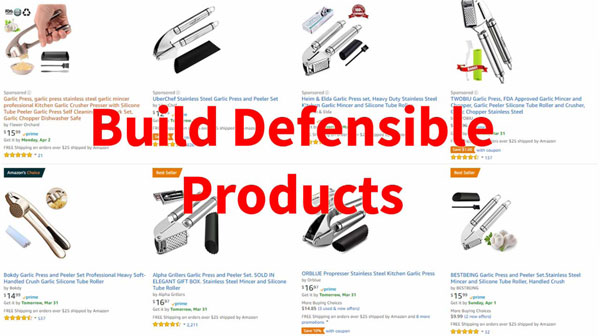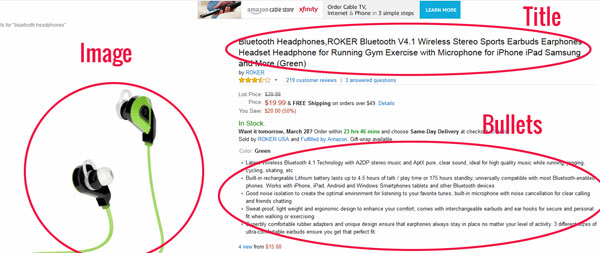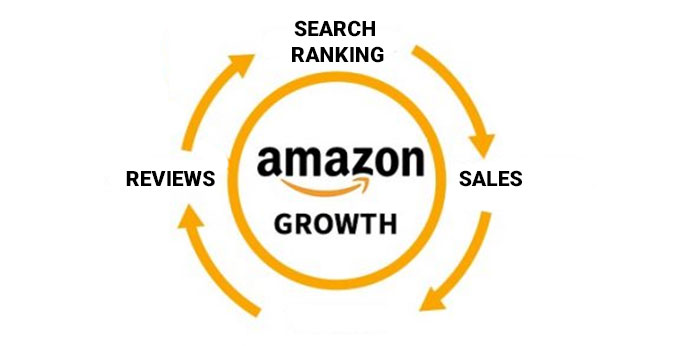The Amazon flywheel effect has allowed Amazon to grow into one of the largest ecommerce companies in the world.
It’s a strategy that leverages customer experience and low prices to create a positive cycle of growth and competitive differentiation.
In this post, we’ll breakdown the elements of the Amazon flywheel and how you can apply it to your ecommerce business.
Are you interested in creating a strong, defensible brand for your products? If so, I put together a comprehensive package of resources that will help you launch your own online store from complete scratch. Be sure to grab it before you leave!
What Is The Amazon Flywheel?
The Amazon flywheel is a strategy that employs low prices, a large selection of products and an excellent customer experience to create a virtuous cycle of growth. More sales leads to a greater selection of goods and lower prices which creates a positive feedback loop.
The Amazon flywheel consists of 3 components.
- Low prices
- Large selection of products
- An excellent customer experience
All 3 components work together and any effort made in one area leads to an improvement in all other areas.
- Low prices attract customers to shop on Amazon
- A fantastic customer experience leads to repeat business and increased traffic to the site
- More traffic and sales leads to a larger selection of products and economies of scale
- Larger economies of scale leads to lower prices
- Rinse and repeat
While it requires an enormous amount of energy to set a flywheel in motion, a moving flywheel carries momentum which allows itself to turn on its own.
A Detailed Breakdown Of The Amazon Flywheel
The Amazon flywheel works by attracting customers with low prices and providing them with an amazing shopping experience.
The beauty of the Amazon flywheel is how Amazon leverages their sales to reduce prices and carry a larger selection of products.
Early on, Jeff Bezos’ vision was for Amazon to become the “everything store”. Instead of just offering Amazon owned products, they focused on allowing 3rd party sellers to sell their own products on Amazon.
Today, 3rd party sellers account for over 50% of the total sales on Amazon. And 3rd party sellers allow Amazon to sell “everything” without having to take on any additional work.
Overall, a larger selection of products allows Amazon to capture a larger piece of the market and greatly improves the customer experience.
Meanwhile, Amazon operates at extremely tight margins. Instead of taking a profit, Amazon uses its cash to lower prices to customers while still generating enough money to sustain its day to day operations.
Lower prices leads to more sales which makes it more appealing for 3rd party sellers and brands to offer their products on the Amazon marketplace.
In addition, initiatives like Amazon Prime membership lock in existing customers to their platform.
Every strategy that Amazon employs in their business is designed to strengthen their flywheel. Feeding any part of the flywheel accelerates the loop.
How To Apply The Amazon Flywheel To Your Amazon FBA Business
Any business can implement their own version of the Amazon flywheel but you must first identify the critical elements.
For example, if you run an Amazon FBA business, here’s what your flywheel would look like.
- Find a defensible product to sell
- Create a high converting Amazon listing
- Drive traffic to your products
- Provide great customer service
- Solicit Amazon reviews
- Achieve better rankings
- Generate more sales
Find A Defensible Product To Sell
Implementing the Amazon flywheel starts with a solid foundation which requires that you sell high quality products.
If your products are subpar, then customers will not buy your goods no matter how much traffic you generate.
Here’s a step by step guide on how to find the best products to sell on Amazon
- Find a product to sell where you can add value and differentiate yourself from the competition.
- Analyze Amazon search to make sure your products have high demand and low competition.
- Find a wholesale supplier that can manufacture your products at low prices. Start with a sample and make your first bulk purchase. Try to negotiate a lower MOQ.
- Make sure you can make a profit after all Amazon selling fees
Create A High Converting Amazon Listing
The visibility of your product in Amazon search is based on the conversion rate of your product listing. As a result, the better your Amazon listing, the more sales that you will generate.
There are 4 major components to a high quality Amazon listing.
- Take Great Product Images – Your images are the most important aspect of your listing. Make sure that you fill up every image slot that Amazon offers for your product. Take pictures at multiple angles and include lifestyle shots of your products.
- Create A Keyword Rich Title – Using a tool like Jungle Scout, find out all of the keywords that customers are typing in to search for your product. Then, use these keywords in your title.
- Optimize Your Bullet Points – Use your bullet points to convey your unique value proposition and why customers should buy your products.
- Write A Detailed Product Description – Use Amazon A+ content to create a beautiful product description that emphasizes your brand.
Drive Traffic To Your Products
You won’t make any sales unless customers can find your products. When you first launch, your Amazon listings will have zero visibility and you must drive your own traffic.
Here’s how to generate traffic to your Amazon listings.
- Run Amazon PPC Ads – Amazon allows you to bid on keywords to place your products at the top of the search results.
- Create Content For SEO – By ranking your content in Google search, you can steer visitors over to your Amazon products.
- Run Facebook Ads – Amazon loves external traffic. If you can drive social media traffic to your listings, your product will rise in the Amazon search rankings.
Generate Reviews For Your Products
Amazon reviews provide social proof for your listings and can dramatically improve the conversion rate for your products.
Here are 3 ways to generate reviews for your products.
- Use Amazon Vine – Amazon Vine is a product review program designed to encourage shoppers to leave honest, unbiased reviews in return for free Amazon products. It’s free.
- Use A Feedback Tool – If you don’t ask buyers for reviews, you won’t get any. Use an automated service like Feedback Genius to automatically send review requests.
- Include Product Inserts – By inserting a postcard or pamphlet inside your packaging, you can ask customers to leave a review.
Provide Great Customer Service
As sales start to roll in, you must pay specific attention to your AHR score on seller central. Your account health rating (AHR) is a measure of your customer service performance on Amazon.
Your account health is composed of 3 metrics.
- Customer Service Performance – Your customer service performance is based on your order defect ratio which is defined as the percentage of total orders that resulted in negative seller feedback, a lost A-to-Z guarantee claim or a chargeback.
Your ODR must be less than 1% or else you may face a suspension. To maintain a low ODR, you should respond to all customer inquiries within 24 hours.
- Product Policy Compliance – Your products must follow a long list of Amazon’s policies in order to stay compliant.
- Shipping Performance – You must ship out your orders in a timely fashion. This metric only applies to merchant fulfilled sellers.
How The Amazon Flywheel Works For 3rd Party Sellers
As a 3rd party seller, your Amazon flywheel has 3 main elements.
- Amazon Reviews – More reviews leads to higher Amazon SEO rankings.
- Amazon Rankings – Higher search rankings for your target keywords leads to more sales.
- Amazon Sales – More Amazon sales leads to more reviews.
The hardest part about selling on Amazon is getting the flywheel started. After all…
- You can’t get sales unless customers can find your products in search.
- You can’t rank in search unless you generate sales.
- You can’t generate sales unless your product has positive reviews.
- You can’t get reviews unless you generate sales.
For new sellers, you must generate some initial sales to get the Amazon flywheel moving!
Assuming that you have a high quality product with an optimized Amazon listing, apply this feedback loop to grow your Amazon business.
- Run Amazon PPC ads to generate some initial sales – The initial sales from ads will boost your search rankings for your targeted keywords. Amazon will provide your listings with additional visibility during the first 30 days after launch.
- Use automated tools to solicit reviews – Reviews will increase your conversion rate.
- Reviews and traffic will lead to more sales – More sales will lead to higher rankings.
The Amazon Flywheel Applied To Every Business
Any business that’s built to last must have a flywheel strategy. After all, chasing down customers for every sale is not a sustainable business model.
When applying the flywheel model to your business, remember these elements.
- Your flywheel must have a solid foundation – You must sell something of high quality. A poor product or service will prevent your flywheel from ever spinning.
- You must kickstart your flywheel – Getting the flywheel moving is the hardest part. Be patient and give yourself a long enough runway to get started. Have a solid strategy in place for generating your first sales.
- Your flywheel will move more efficiently as you build up momentum – Have structures in place to turn existing sales into more sales. Avoid 1 off sales as much as possible.
- Once your flywheel has momentum, it will keep spinning on its own!
The Amazon flywheel strategy has allowed Amazon to control over 50% of the ecommerce market. And today, Jeff Bezos is the richest man on the planet.
The strategy works but you must implement it properly. Good luck!

Ready To Get Serious About Starting An Online Business?
If you are really considering starting your own online business, then you have to check out my free mini course on How To Create A Niche Online Store In 5 Easy Steps.
In this 6 day mini course, I reveal the steps that my wife and I took to earn 100 thousand dollars in the span of just a year. Best of all, it's free and you'll receive weekly ecommerce tips and strategies!
Related Posts In Amazon Business Models
- How To Make Money On Amazon – 12 Ways Rated And Explained
- Amazon Associates – How To Start An Amazon Affiliate Store For Less Than $3
- How To Dropship On Amazon In 4 Easy Steps
- A Guide To Online Arbitrage On Amazon And How To Get Started
- What Is Amazon Mechanical Turk And How It Works

Steve Chou is a highly recognized influencer in the ecommerce space and has taught thousands of students how to effectively sell physical products online over at ProfitableOnlineStore.com.
His blog, MyWifeQuitHerJob.com, has been featured in Forbes, Inc, The New York Times, Entrepreneur and MSNBC.
He's also a contributing author for BigCommerce, Klaviyo, ManyChat, Printful, Privy, CXL, Ecommerce Fuel, GlockApps, Privy, Social Media Examiner, Web Designer Depot, Sumo and other leading business publications.
In addition, he runs a popular ecommerce podcast, My Wife Quit Her Job, which is a top 25 marketing show on all of Apple Podcasts.
To stay up to date with all of the latest ecommerce trends, Steve runs a 7 figure ecommerce store, BumblebeeLinens.com, with his wife and puts on an annual ecommerce conference called The Sellers Summit.
Steve carries both a bachelors and a masters degree in electrical engineering from Stanford University. Despite majoring in electrical engineering, he spent a good portion of his graduate education studying entrepreneurship and the mechanics of running small businesses.



















